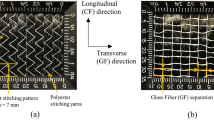Abstract
Carbon fiber reinforced plastic (CFRP) shell structures are often manufactured from a textile structure. Compared to the tensile stiffness of the fibers, textile structures have a low bending stiffness. This low bending stiffness strongly affects the deformation behavior of textile structures, as small bending loads are sufficient for causing significant deformations: e.g. placing the textile structure into a forming tool under gravity. The resulting deformation generally affects the subsequent forming operation. Further, the onset and formation of wrinkles during the forming operation is also influenced by the bending stiffness. For ensuring the manufacturability of CFRP shell structures using finite element based process simulation, the textile specific bending behavior has to be taken into account. For this purpose, a two point bending test is carried out for characterizing the bending behavior of a unidirectional (UD) non-crimp-fabric (NCF). Based on this, the bending stiffness as well as the deflection behavior of the fibrous material is analyzed and compared to a continuous material. For describing this fiber specific material behavior in a FE simulation, a constitutive model is calibrated by applying analytical beam theories. To demonstrate the validity of this straight forward calibration procedure, a gravity load case for placing UD NCF into a forming tool is carried out, both numerically and experimentally.













Similar content being viewed by others
References
Roll K (2011) Application of virtual methods in automotive industry. In: Kolleck R (ed) Tools and technologies for processing ultra high strength materials. Graz, Austria, pp 81–86
Boisse P, Hamila N, Vidal-Sallé E, Dumont F (2011) Simulation of wrinkling during textile composite reinforcement forming. Influence of tensile, in-plane shear and bending stiffnesses. Compos Sci Technol 71:683–692
Belytschko T, Liu WK, Moran B (2000) Nonlinear finite elements for continua and structures. John Wiley & Sons Ltd., New York
Yu WR, Zampaloni M, Pourboghrat F, Chung K, Kang TJ (2005) Analysis of flexible bending behavior of woven preform using non-orthogonal constitutive equation. Compos Part A Appl Sci Manuf 36:839–850
Cornelissen B, Akkerman R (2009) Analysis of yarn bending behavior. In: ICCM-17 17th international conference on composite materials, Edinburgh, pp 1–10
Hu J (2004) Structure and mechanics of woven fabrics. Woodhead Publishing Ltd., Cambridge
Gereke T, Döbrich O, Hübner M, Cherif C (2013) Experimental and computational composite textile reinforcement forming: a review. Compos Part A Appl Sci Manuf 46:1–10
DIN 53362:2003-10 (2003) Testing of plastic films and textile fabrics (excluding nonwovens), coated or not coated with plastics—determination of stiffness in bending—method according to Cantilever. Deutsches Institut für Normung
Kawabata S (1980) The standardization and analysis of hand evaluation. The Textile Machinery Society of Japan, Osaka
Bilbao E, Soulat D, Hivet G, Gasser A (2010) Experimental study of bending behaviour of reinforcements. Exp Mech 50:333–351
Aimène Y, Vidal-Sallé E, Hagège B, Sidoroff F, Boisse P (2010) A hyperelastic approach for composite reinforcement large deformation analysis. J Compos Mater 44:5–26
Rogers TG, Pipkin AC (1971) Small deflections of fiber-reinforced beams or slabs. J Appl Mech 38:1047–1048
DIN 53121:2008-10 (2008) Testing of paper and board—determination of the bending stiffness by the beam method
Raut A, Reddy JN (2010) Assessment of least-squares finite element models of beams. Asian J Civil Eng (Build Hous) 11:1–24
Schürmann H (2005) Konstruieren mit Faser-Kunststoff-Verbunden. Springer, Berlin
Bonet J, Burton AJ (1998) A simple orthotropic, transversely isotropic hyperelastic constitutive equation for large strain computations. Comput Methods Appl Mech Eng 162:151–164
Holzapfel GA (2000) Nonlinear solid mechanics: a continuum approach for engineering. John Wiley & Sons Ltd., New York
Livermore Software Technology Corporation (2006) LS-DYNA THEORY MANUAL, Version 2006
Acknowledgments
The authors would like to thank Doris Gehm and Christian Keintzel, BMW Group, for interesting discussions and their support with the bending tests.
Author information
Authors and Affiliations
Corresponding author
Rights and permissions
About this article
Cite this article
Senner, T., Kreissl, S., Merklein, M. et al. Bending of unidirectional non-crimp-fabrics: experimental characterization, constitutive modeling and application in finite element simulation. Prod. Eng. Res. Devel. 9, 1–10 (2015). https://doi.org/10.1007/s11740-014-0568-5
Received:
Accepted:
Published:
Issue Date:
DOI: https://doi.org/10.1007/s11740-014-0568-5




